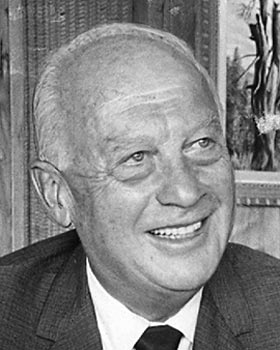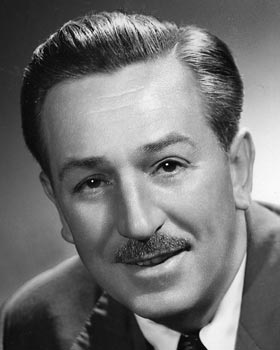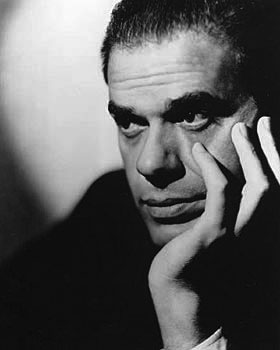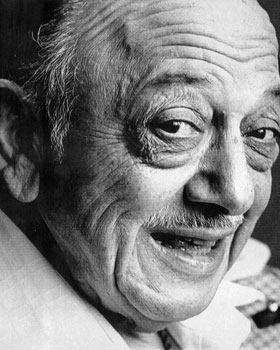Walter Lantz
Walter Lantz emerged from the ranks of animation's early pioneers to build a multimillion-dollar cartoon empire and a respected worldwide reputation with the creation of an irascible woodpecker named Woody.
In 1978, Lantz was given a special Academy Award "for bringing joy and laughter to every part of the world."
It was during Lantz's honeymoon with actress Grace (Gracie) Stafford in 1941 at a lakeside cottage that Lantz found the inspiration for his most famous character, when the couple found a woodpecker drilling holes in the shingles on the roof. Gracie Lantz suggested adapting the bird as a cartoon character.
The character, Woody Woodpecker, debuted soon after as a supporting character in an Andy Panda short, "Knock Knock."
After the first three Woody cartoons were completed in the early 1940s, Mel Blanc, who had supplied the character's voice, signed an exclusive contract at Warner Bros. In 1948, Blanc sued Lantz for more than half a million dollars, claiming that his original laugh had been used in subsequent cartoons without his permission. Although a judge ruled against Blanc, noting that he had failed to copyright his contribution, Lantz paid Blanc in an out-of-court settlement.
In 1950, Lantz was preparing another series of Woody Woodpecker cartoons at United Artists and needed a new voice. After being turned down by her husband because Woody was a boy, Gracie Lantz taped her own audition and secretly added it to the other recordings.
The artist picked Gracie Lantz's recording in a blind listening session. She provided Woody's voice and boisterous laugh in hundreds of cartoons until her death in March 1992 at age 88.
The son of Italian immigrants, Lantz was born in New Rochelle, N.Y. At 15, he traveled to New York, where he worked as an office boy at a William Randolph Hearst newspaper and attended classes at an art school.
In 1916, Morrell Goddard, who had created the nation's first color newspaper comic section, offered the aspiring teenage artist a job in the animation department of Hearst's International Film Service. By 1922, Lantz was working as a producer at the John Randolph Bray studio.
Four years later, Lantz moved to Hollywood, where he was briefly employed with Frank Capra as a gag writer for silent-film director Mack Sennett. In 1928, after a friend's recommendation, Lantz was hired to oversee Universal Film Co.'s animation department. Lantz arrived just as a young cartoonist named Walt Disney was leaving, taking with him his idea for an animated mouse—which Universal had rejected.
Disney had left behind a character named Oswald the Rabbit, which Lantz quickly redesigned and copyrighted.
In 1930, he made animation history by producing the first Technicolor cartoon — the five-minute opening sequence of "The King of Jazz."
Lantz was honored in 1959 by the Los Angeles City Council as "one of America's most outstanding animated film cartoonists." In 1973, the international animation society, ASIFA/Hollywood, presented him with its Annie award.
Related stars
|
|
Points of interest
Academy Awards
| Year | Category | Work | |
|---|---|---|---|
| 1932 | Best Short Subject - Cartoon | The Merry Old Soul | Nomination |
| 1934 | Best Short Subject - Cartoon | Jolly Little Elves | Nomination |
| 1941 | Best Short Subject - Cartoon | Boogie Woogie Bugle Boy of Company B | Nomination |
| 1942 | Best Short Subject - Cartoon | Juke Box Jamboree | Nomination |
| 1943 | Best Short Subject - Cartoon | The Dizzy Acrobat | Nomination |
| 1944 | Best Short Subject - Cartoon | Fish Fry | Nomination |
| 1945 | Best Short Subject - Cartoon | The Poet and the Peasant | Nomination |
| 1946 | Best Short Subject - Cartoon | Chopin's Musical Moments | Nomination |
| 1954 | Best Short Subject - Cartoon | Crazy Mixed Up Pup | Nomination |
| 1955 | Best Short Subject - Cartoon | The Legend of Rock-a-bye Point | Nomination |
| 1978 | Honorary Award | Win |





Share a thought about Walter Lantz